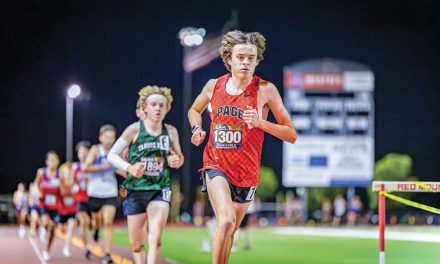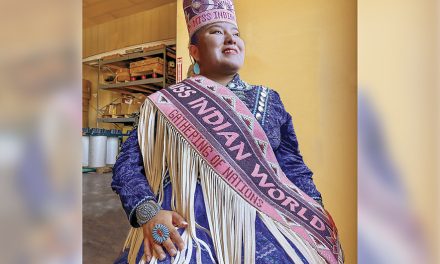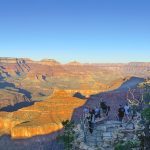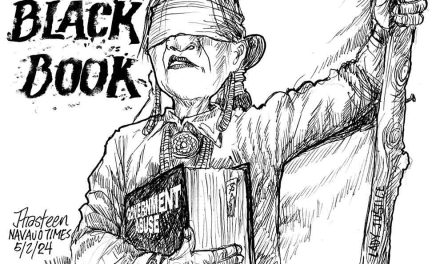
Even 5-mile buffer too much for allottees near Chaco
WINDOW ROCK
Naabik’iyati’ Committee voted last Thursday to support reducing the proposed drilling buffer zone around Chaco Canyon from 10 miles to five miles.
But that’s still too much space for some allotment owners in the area, who say the zone will prevent them from leasing their mineral rights.
After the vote, a group of allotment owners applauded — but if they had their way, they had told President Jonathan Nez before the committee convened, there would be no buffer zone at all.
Before the committee had convened to debate on the legislation, the group of protesters, travelling in from communities such as Nageezi and Counselor, New Mexico, marched to the front of the President’s Office to voice their opposition to Nez’s and Vice President Myron Lizer’s support of the 10-mile buffer zone. Nez had seen the group marching in while he was on his way to his office; once they got to his office he came out to talk with them.
Nez told the protesters he appreciated the grassroots group, and told them he was told U.S. Sen. Mark Heinrich (D-N.M.) was considering visiting the Navajo Nation to listen to what they had to say. Heinrich is on the Senate Committee on Energy and Natural Resources, and is co-sponsoring Senate Bill 1079, which includes the 10-mile buffer. The bill, also called the Chaco Cultural Heritage Area Protection Act of 2019, is also sponsored by Sen. Tom Udall (D-N.M.).
Nez also mentioned he was understood that the buffer zone reduction Council was proposing was agreed upon by the grassroots group, but that was met with a vehement “No!”
“There’s been a counter-proposition of a five-mile buffer zone. Is everyone all OK with that?” asked Nez. “The bill going through Council, when they introduced that they told us that the residents were OK with the five-mile buffer.”
“No!” yelled the group, who claimed they were never consulted over the buffer zone.
Members of the group like Etta Wilson, who needs wheelchair assistance, said they were never consulted by anyone to discuss any buffer.
“We were never told! I was never informed or invited to a meeting,” said Wilson to Nez.
Later on Wilson said she did not want the buffer zone at all because they benefit from oil companies and the royalties they receive from them to drill on their allotments. For some, these royalties are how they provide for their families.
“As a resident that has lived there all my life I’ve never been asked how I feel about the buffer zone,” emphasized Wilson, who also said the National Park Service may be in her back yard, but they do absolutely nothing for the communities surrounding the park, such as hiring Navajos or allowing residents to get water inside the park, like they once had.
“I travel 80 miles round trip to Lybrook to get water,” said Wilson. “I don’t see why we should help them (NPS), when they don’t help us!”
Delora Hesase, who is a third-generation allottee, said this buffer zone is a real concern, even moreso for the elderly. She said environmentalists who don’t live in the area drown out any buffer zone opposition.
After listening to the protesters, Nez repeated Heinrich’s offer of a possible meeting. The group said they’ve been trying to meet with the senator with for years, and should he visit then a meeting with the group should take precedence over any other engagements.
Earlier this month Council Delegate Freeland, Speaker Seth Damon and other members of Council met with Heinrich to discuss the Chaco Canyon buffer zone.
“Let me just commit to you all, that we all sit down with Senator Heinrich and we will meet where everyone is OK with,” said Nez after asking for contact information.
After speaking with Nez and Lizer, the group made its way inside the Council Chamber to hear the deliberation of the bill, which would provide Navajo Nation support to Congress to amend the 10-mile buffer zone as currently stated in H.R. 2181 and S. 1019 by half. The Navajo Nation legislation, for which Naabi is the last stopping ground, is merely a position statement; the final authority rests with Congress.
Freeland, who sponsored the buffer zone reduction, said Heinrich consulted with the previous Council, but “there was no proper consultation on this new body on the 24th Navajo Nation Council.”
He pointed to a U.S. House subcommittee hearing last April. “I was there to meet people and talk about the issue, but what I witnessed there was a dis-acknowledgment to our people who were there,” he said.
But Freeland said after that meeting in April, his Resource and Development Committee had held a field hearing in Nageezi in June of last year, and there was another field hearing in November.
Freeland said that in addition to the allottees directly affected by the zone, there are 22,000 additional allottees who would be impacted, because it would create a “land lock” which would prevent access to adjacent properties. It would also interfere with transportation of resources through the buffer zone because that would be deemed trespassing.
Protesters put much blame on Health, Education and Human Services Committee Chair Daniel Tso for intensifying the buffer zone position. During the Naabik’iyati’ meeting, Tso said not all the allottees reside in the buffer area. He said consultation did happen with certain allotment owners within the 10-mile buffer zone on Jan. 9.
“The original author of this legislation didn’t know that HR #2181 (the companion legislation to Heinrich’s and Udall’s bill) had passed the House,” said Tso. “My intent is that the Navajo position is based on real-time facts and what is happening in Congress. This position that has been read into the record, motioned and seconded basically is off-target.”
Resource and Development Committee member Herman Daniels raised a question of privilege to ask if Tso has a conflict of interest since he is an allotment owner. Tso explained he is an heir to 23 allotments, and four of those allotments are outside of the 10-mile buffer, which are leased, and he has received royalties for. But, there are allotments within the buffer zone that are used for grazing leases.
“I hope this is a teaching moment to all elected officials. When there is an appearance of conflict of interest then the member should recuse themself,” said Tso, before he voluntarily recused himself after Department of Justice and Chief legislative Counsel Dana Barbroff determinated he wasn’t in conflict of interest.
Law and Order Committee Vice Chair Otto Tso said consultation happened, but it didn’t happen with Council, only at the President’s office and it was that office that determined to agree to the buffer zone.
“The president’s office made the determination to say ‘Yes. This is this the Navajo Nation’s position and we are OK with the 10-mile buffer,” said Otto Tso. “The federal government did not put in the economic solution that lives within the 10-mile buffer!”
This buffer zone issue is not new. It has been ongoing for years now and from what some said, the buffer started off as a 50 miles, but dwindled over the years to finally 10 miles and now possibly five miles if Navajo Nation Council’s position is considered.
“We said one thing and then it becomes another thing, and that doesn’t speak well for Navajo,” said Lizer. “It doesn’t unify us. We need more discussion, obviously. Hopefully, we can come to a happy medium.”
The bill was approved 18-1 and Naabik’iyati’ was the final authority.








 Highway 264,
Highway 264, I-40, WB @ Winslow
I-40, WB @ Winslow